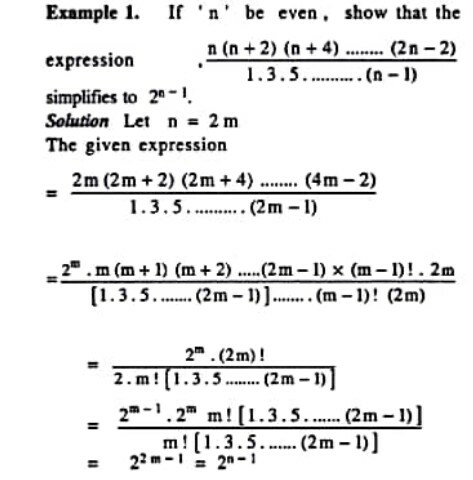Question Number 57363 by Tawa1 last updated on 03/Apr/19

Commented by Tawa1 last updated on 03/Apr/19
![Please help. my problem is from ((2^m . m(m + 1)(m + 2) .... (2m − 1))/(1.3.5. ....... (2m − 1))) now why did they multiply Numerator and denominator by (m − 1)!. 2m to get ... ((2^m . m(m + 1)(m + 2) .... (2m − 1) × (m − 1)!. 2m)/([1.3.5. ....... (2m − 1)] ....... . (m − 1)! . 2m )) And suddenly becomes ((2^m . (2m)!)/([1.3.5. ....... (2m − 1)] ....... . (m − 1)! . 2m )) And later. ((2^m . 2^m m![1.3.5 . .... (2m − 1)])/([1.3.5. ....... (2m − 1)] ....... . (m − 1)! . 2m )) So, i don′t understand all the steps jump. I don′t want to cram, i want to understand the steps because of exam.](https://www.tinkutara.com/question/Q57364.png)
$$\mathrm{Please}\:\mathrm{help}.\:\mathrm{my}\:\mathrm{problem}\:\mathrm{is}\:\mathrm{from}\:\:\frac{\mathrm{2}^{\mathrm{m}} \:.\:\mathrm{m}\left(\mathrm{m}\:+\:\mathrm{1}\right)\left(\mathrm{m}\:+\:\mathrm{2}\right)\:….\:\left(\mathrm{2m}\:−\:\mathrm{1}\right)}{\mathrm{1}.\mathrm{3}.\mathrm{5}.\:…….\:\left(\mathrm{2m}\:−\:\mathrm{1}\right)} \\ $$$$\mathrm{now}\:\mathrm{why}\:\mathrm{did}\:\mathrm{they}\:\mathrm{multiply}\:\mathrm{Numerator}\:\mathrm{and}\:\mathrm{denominator}\:\mathrm{by} \\ $$$$\left(\mathrm{m}\:−\:\mathrm{1}\right)!.\:\mathrm{2m}\:\:\mathrm{to}\:\mathrm{get}\:… \\ $$$$\:\:\:\:\:\:\:\:\:\:\:\:\:\:\:\:\:\:\:\:\:\:\:\:\:\:\:\:\:\:\:\:\:\:\:\:\:\:\:\:\:\:\:\:\:\:\:\:\:\:\:\:\:\:\:\:\:\:\:\:\:\frac{\mathrm{2}^{\mathrm{m}} \:.\:\mathrm{m}\left(\mathrm{m}\:+\:\mathrm{1}\right)\left(\mathrm{m}\:+\:\mathrm{2}\right)\:….\:\left(\mathrm{2m}\:−\:\mathrm{1}\right)\:×\:\left(\mathrm{m}\:−\:\mathrm{1}\right)!.\:\mathrm{2m}}{\left[\mathrm{1}.\mathrm{3}.\mathrm{5}.\:…….\:\left(\mathrm{2m}\:−\:\mathrm{1}\right)\right]\:…….\:.\:\left(\mathrm{m}\:−\:\mathrm{1}\right)!\:.\:\mathrm{2m}\:} \\ $$$$\mathrm{And}\:\mathrm{suddenly}\:\mathrm{becomes} \\ $$$$\:\:\:\:\:\:\:\:\:\:\:\:\:\:\:\:\:\:\:\:\:\:\:\:\:\:\:\:\:\:\:\:\:\:\:\:\:\:\:\:\frac{\mathrm{2}^{\mathrm{m}} \:.\:\left(\mathrm{2m}\right)!}{\left[\mathrm{1}.\mathrm{3}.\mathrm{5}.\:…….\:\left(\mathrm{2m}\:−\:\mathrm{1}\right)\right]\:…….\:.\:\left(\mathrm{m}\:−\:\mathrm{1}\right)!\:.\:\mathrm{2m}\:} \\ $$$$\mathrm{And}\:\mathrm{later}.\: \\ $$$$\:\:\:\:\:\:\:\:\:\:\:\:\:\:\:\:\:\:\:\:\:\:\:\:\:\:\:\:\:\:\:\:\:\:\:\:\:\:\:\:\frac{\mathrm{2}^{\mathrm{m}} \:.\:\mathrm{2}^{\mathrm{m}} \:\:\mathrm{m}!\left[\mathrm{1}.\mathrm{3}.\mathrm{5}\:.\:….\:\left(\mathrm{2m}\:−\:\mathrm{1}\right)\right]}{\left[\mathrm{1}.\mathrm{3}.\mathrm{5}.\:…….\:\left(\mathrm{2m}\:−\:\mathrm{1}\right)\right]\:…….\:.\:\left(\mathrm{m}\:−\:\mathrm{1}\right)!\:.\:\mathrm{2m}\:} \\ $$$$\mathrm{So},\:\mathrm{i}\:\mathrm{don}'\mathrm{t}\:\mathrm{understand}\:\mathrm{all}\:\mathrm{the}\:\mathrm{steps}\:\mathrm{jump}. \\ $$$$ \\ $$$$\mathrm{I}\:\mathrm{don}'\mathrm{t}\:\mathrm{want}\:\mathrm{to}\:\mathrm{cram},\:\mathrm{i}\:\mathrm{want}\:\mathrm{to}\:\mathrm{understand}\:\mathrm{the}\:\mathrm{steps}\:\mathrm{because} \\ $$$$\mathrm{of}\:\mathrm{exam}.\: \\ $$
Commented by tanmay.chaudhury50@gmail.com last updated on 03/Apr/19
![look at the D_r =1.3.5....(n−1) D_r =(n−1)...5.3.1 ←look even number are missing so D_r =[(n−1)(n−2)(n−3)(n−4)..6.5.4.3.2.1]×(1/((n−2)(n−4)..6.4.2)) here i have inserted even numbers and devided by same even numbers to keep the value of D_r =fixed D_r =(1/((n−2)(n−4)...6.4.2))×(n−1)(n−2)(n−3)..6.5.4.3.2.1 D_r =(((n−1)!)/((n−2)(n−4)..6.4.2)) now (N_r /D_r )=((n(n+2)(n+4)..(2n−2))/(((n−1)!)/((n−2)(n−4)..6.4.2))) (N_r /D_r )=(((2n−2)(2n−4)...(n+4)(n+2)n×(n−2)(n−4)(n−6)..6.4.2)/((n−1)∙)) let n=2k (N_r /D_r )=(((4k−2)(4k−4)..(2k+4)(2k+2)(2k)(2k−2)(2k−4)(2k−6)..6.4.2)/((2k−1)!)) now in AP series first term=2 common difference=+2 T_r =2+(r−1)2→2r 2r=4k−2 hence r=2k−1 (N_r /D_r )=((2(2k−1)×2(2k−2)×..2(k+2)×2(k+1)×2(k)×2(k−1)×2(k−3)..2×(3)×2(2)×2(1))/((2k−1)!)) now how many 2 are multiplied in N_r .. we have caculated using AP series formula that is r→ [r=2k−1] so (N_r /D_r )=((2^(2k−1) ×(2k−1)(2k−2)×..(k+2)(k+1)(k)(k−1)..3.2.1)/((2k−1))) =((2^(2k−1) ×(2k−1)!)/((2k−1)!)) =2^(2k−1) =2^(n−1) [n=2k we clnsidered]](https://www.tinkutara.com/question/Q57370.png)
$${look}\:{at}\:{the}\:{D}_{{r}} =\mathrm{1}.\mathrm{3}.\mathrm{5}….\left({n}−\mathrm{1}\right) \\ $$$${D}_{{r}} =\left({n}−\mathrm{1}\right)…\mathrm{5}.\mathrm{3}.\mathrm{1}\:\:\leftarrow{look}\:{even}\:{number}\:{are}\:{missing} \\ $$$${so}\:{D}_{{r}} =\left[\left({n}−\mathrm{1}\right)\left({n}−\mathrm{2}\right)\left({n}−\mathrm{3}\right)\left({n}−\mathrm{4}\right)..\mathrm{6}.\mathrm{5}.\mathrm{4}.\mathrm{3}.\mathrm{2}.\mathrm{1}\right]×\frac{\mathrm{1}}{\left({n}−\mathrm{2}\right)\left({n}−\mathrm{4}\right)..\mathrm{6}.\mathrm{4}.\mathrm{2}} \\ $$$${here}\:{i}\:{have}\:{inserted}\:{even}\:{numbers}\:{and}\:{devided} \\ $$$${by}\:{same}\:{even}\:{numbers}\:{to}\:{keep}\:{the}\:{value}\:{of} \\ $$$${D}_{{r}} ={fixed} \\ $$$${D}_{{r}} =\frac{\mathrm{1}}{\left({n}−\mathrm{2}\right)\left({n}−\mathrm{4}\right)…\mathrm{6}.\mathrm{4}.\mathrm{2}}×\left({n}−\mathrm{1}\right)\left({n}−\mathrm{2}\right)\left({n}−\mathrm{3}\right)..\mathrm{6}.\mathrm{5}.\mathrm{4}.\mathrm{3}.\mathrm{2}.\mathrm{1} \\ $$$${D}_{{r}} =\frac{\left({n}−\mathrm{1}\right)!}{\left({n}−\mathrm{2}\right)\left({n}−\mathrm{4}\right)..\mathrm{6}.\mathrm{4}.\mathrm{2}} \\ $$$${now} \\ $$$$\frac{{N}_{{r}} }{{D}_{{r}} }=\frac{{n}\left({n}+\mathrm{2}\right)\left({n}+\mathrm{4}\right)..\left(\mathrm{2}{n}−\mathrm{2}\right)}{\frac{\left({n}−\mathrm{1}\right)!}{\left({n}−\mathrm{2}\right)\left({n}−\mathrm{4}\right)..\mathrm{6}.\mathrm{4}.\mathrm{2}}} \\ $$$$\frac{{N}_{{r}} }{{D}_{{r}} }=\frac{\left(\mathrm{2}{n}−\mathrm{2}\right)\left(\mathrm{2}{n}−\mathrm{4}\right)…\left({n}+\mathrm{4}\right)\left({n}+\mathrm{2}\right){n}×\left({n}−\mathrm{2}\right)\left({n}−\mathrm{4}\right)\left({n}−\mathrm{6}\right)..\mathrm{6}.\mathrm{4}.\mathrm{2}}{\left({n}−\mathrm{1}\right)\centerdot} \\ $$$$ \\ $$$${let}\:{n}=\mathrm{2}{k}\:\: \\ $$$$\frac{{N}_{{r}} }{{D}_{{r}} }=\frac{\left(\mathrm{4}{k}−\mathrm{2}\right)\left(\mathrm{4}{k}−\mathrm{4}\right)..\left(\mathrm{2}{k}+\mathrm{4}\right)\left(\mathrm{2}{k}+\mathrm{2}\right)\left(\mathrm{2}{k}\right)\left(\mathrm{2}{k}−\mathrm{2}\right)\left(\mathrm{2}{k}−\mathrm{4}\right)\left(\mathrm{2}{k}−\mathrm{6}\right)..\mathrm{6}.\mathrm{4}.\mathrm{2}}{\left(\mathrm{2}{k}−\mathrm{1}\right)!} \\ $$$${now}\:{in}\:{AP}\:{series}\:{first}\:{term}=\mathrm{2} \\ $$$${common}\:{difference}=+\mathrm{2} \\ $$$${T}_{{r}} =\mathrm{2}+\left({r}−\mathrm{1}\right)\mathrm{2}\rightarrow\mathrm{2}{r} \\ $$$$\mathrm{2}{r}=\mathrm{4}{k}−\mathrm{2}\:\:\:{hence}\:{r}=\mathrm{2}{k}−\mathrm{1} \\ $$$$\frac{{N}_{{r}} }{{D}_{{r}} }=\frac{\mathrm{2}\left(\mathrm{2}{k}−\mathrm{1}\right)×\mathrm{2}\left(\mathrm{2}{k}−\mathrm{2}\right)×..\mathrm{2}\left({k}+\mathrm{2}\right)×\mathrm{2}\left({k}+\mathrm{1}\right)×\mathrm{2}\left({k}\right)×\mathrm{2}\left({k}−\mathrm{1}\right)×\mathrm{2}\left({k}−\mathrm{3}\right)..\mathrm{2}×\left(\mathrm{3}\right)×\mathrm{2}\left(\mathrm{2}\right)×\mathrm{2}\left(\mathrm{1}\right)}{\left(\mathrm{2}{k}−\mathrm{1}\right)!} \\ $$$${now}\:{how}\:{many}\:\mathrm{2}\:{are}\:{multiplied}\:{in}\:{N}_{{r}} .. \\ $$$${we}\:{have}\:{caculated}\:\:{using}\:{AP}\:{series}\:{formula} \\ $$$$\:{that}\:{is}\:{r}\rightarrow\:\:\left[{r}=\mathrm{2}{k}−\mathrm{1}\right] \\ $$$${so}\:\frac{{N}_{{r}} }{{D}_{{r}} }=\frac{\mathrm{2}^{\mathrm{2}{k}−\mathrm{1}} ×\left(\mathrm{2}{k}−\mathrm{1}\right)\left(\mathrm{2}{k}−\mathrm{2}\right)×..\left({k}+\mathrm{2}\right)\left({k}+\mathrm{1}\right)\left({k}\right)\left({k}−\mathrm{1}\right)..\mathrm{3}.\mathrm{2}.\mathrm{1}}{\left(\mathrm{2}{k}−\mathrm{1}\right)} \\ $$$$=\frac{\mathrm{2}^{\mathrm{2}{k}−\mathrm{1}} ×\left(\mathrm{2}{k}−\mathrm{1}\right)!}{\left(\mathrm{2}{k}−\mathrm{1}\right)!} \\ $$$$=\mathrm{2}^{\mathrm{2}{k}−\mathrm{1}} \\ $$$$=\mathrm{2}^{{n}−\mathrm{1}} \:\:\left[{n}=\mathrm{2}{k}\:{we}\:{clnsidered}\right] \\ $$
Commented by Tawa1 last updated on 03/Apr/19

$$\mathrm{Wow}.\:\mathrm{God}\:\mathrm{bless}\:\mathrm{you}\:\mathrm{sir}. \\ $$
